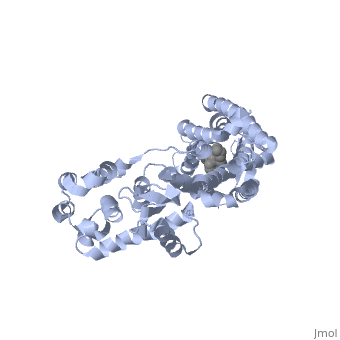Sandbox Reserved 1446
From Proteopedia
(Difference between revisions)
| Line 6: | Line 6: | ||
Amyloids are accumulated proteins that are folded up into a shape that allows for continual copies to be made of each protein. These proteins then create fibrils that is generated in the bone marrow and deposited throughout all organs and tissues. Numerous diseases can be credited to the over abundance of amyloid fibrils. Amyloids can be formed by many different proteins and polypeptides. Amyloids are formed by polymerization of monomeric peptides into fibers. It takes thousands and thousands to create a single fiber of amyloid. The formation relies on the sequance heavily, meaning any mutations can cause the assembly process to shut down. | Amyloids are accumulated proteins that are folded up into a shape that allows for continual copies to be made of each protein. These proteins then create fibrils that is generated in the bone marrow and deposited throughout all organs and tissues. Numerous diseases can be credited to the over abundance of amyloid fibrils. Amyloids can be formed by many different proteins and polypeptides. Amyloids are formed by polymerization of monomeric peptides into fibers. It takes thousands and thousands to create a single fiber of amyloid. The formation relies on the sequance heavily, meaning any mutations can cause the assembly process to shut down. | ||
| - | When amyloids were first discovered, they were mistaken by the German scientist, Rudolf Virchow, to be starch. This was due to it's reaction with iodine staining of the time. It was in 1859 that the scientific community found that they were not starch, fatty acid deposits, or carbohydrate deposits; but instead albumoid proteinaceous material. | + | When amyloids were first discovered, they were mistaken by the German scientist, Rudolf Virchow, to be starch. This was due to it's reaction with iodine staining of the time. It was in 1859 that the scientific community found that they were not starch, fatty acid deposits, or carbohydrate deposits; but instead albumoid proteinaceous material, which means it is made of a protein created by abumins. |
== Structure == | == Structure == | ||
The structure of the fibers typically form quaternary beta-sheet structures. The quaternary structure creates a larger group of polypeptides and proteins, which is stabilized by hydrogen bonds, disulfide-bridges, and salt-bridges. | The structure of the fibers typically form quaternary beta-sheet structures. The quaternary structure creates a larger group of polypeptides and proteins, which is stabilized by hydrogen bonds, disulfide-bridges, and salt-bridges. | ||
Revision as of 20:13, 30 April 2018
| This Sandbox is Reserved from Jan 22 through May 22, 2018 for use in the course Biochemistry II taught by Jason Telford at the Maryville University, St. Louis, Missouri, USA. This reservation includes Sandbox Reserved 1446 through Sandbox Reserved 1455. |
To get started:
More help: Help:Editing |
Amyloid
| |||||||||||

